

|
Home Updates Hydros Cars Engines Contacts Links Racing Contact On The Wire |
Mons Gems Suzor
|
|
Gems Suzor’s interest in boats seems to have begun around 1909 when he carved out a 800mm long hull from solid wood and fitted it with a small German steam engine. Since this was little more than a toy it was soon put aside and replaced with others fitted with IC, electrical and compressed air engines. Whilst working in Germany in 1912, Gems got involved with model aircraft, winning first prize with a rubber driven plane at an international event at Fuhlsbuttel, now Hamburg Airport. In a Zeppelin hangar there, Suzor's plane flew twice the distance of any other competitor. The following year he built one powered by a compressed air motor that that won first prize at another international event in Rundsberg as well as several first prizes in local competitions. In May 1914 he appeared with a petrol engined model of two metres span but WW 1 put paid to any more work on that. |
During the war, Suzor served on the Western front including a period in 1916 as a despatch rider carrying messages dropped from observation aircraft. Even whilst serving he managed to build model boats, including a 600mm hull from mahogany with a steam engine that had trial runs on a Belgian river. After the war ended he married Edith Suzor, a distant cousin, hence the shared name.
|
In 1921 he saw an advert for a model boat competition to be held annually and organised by the ‘Auto’ magazine. For this he built his first recognisable hydroplane hull, 'Puma', 900mm long and powered by a five cylinder, radial CO2 motor, which although able to reach around 13mph, soon ran out of gas, leading Suzor to start work on another petrol engine. Although completed in 1924, the motor was not really working until 1925 when a major re-design cured the problems. The boat was named ‘Canard’, the first of his craft to really make an impact. Its first outing was in June 1925 at The Tuileries Gardens in Paris where it won the ‘Bovril’ cup. In September that year he brought Canard to Victoria Park for the inaugural MPBA International Regatta, the first of his regular visits to Britain over the next forty years. Canard won the event with an average speed of 16mph from a standing start, and this on the straight course. He returned to Victoria in 1926, winning the 100yds straight race again. Right: Caption reads 'Petrol boat Canard 1st prize (13 secs) Mon's G M Suzor Paris Sunday Sept 13th/1925'. |
|
The motor for Canard was just over 17cc, very small compared with the other IC motors of the time and started with a key, but unlike Ted Vanner's where the key worked directly on the crankshaft, Suzor's turned the motor via a large bevel gear onto a corresponding, but much smaller, gear on the crankshaft.
In 1927 a new boat appeared, the first of his boats named after his eldest daughter ‘Nickie’. This was a development of Canard, now with a 30cc motor, built with the intention of matching the flash steam boats of the period. It did incorporate an innovation that became standard practice on hydros and is still evident on every boat to this day, the parallel skeg with universal jointed prop shaft. Unfortunately the weight of the engine made the boat unstable so ‘Nickie II’ was conceived in 1928 and first run in May 1929 at Herblay where it won the first ever Model Yacht Club Cup race at 22mph followed by the Bovril cup again at the Tuileries. In August that year at Lac Daumersil Suzor set a new World Record for IC engined boats at 25mph. Returning to Victoria for the International, he won that trophy on the circular course at 22mph for 500yds. Back in France he set a new World Record in November at 32mph.
The 1930 and 1931 International regattas saw Suzor and ‘Nickie II’ win on both occasions, taking the International Trophy outright for his third win. This trophy was a punchbowl that had been presented by Edward Hobbs, along with Ted Vanner and W. Savage who had raced against Suzor in Paris in 1924. The replacement 'International trophy' is still being competed for. At the 1931 event he did a demonstration run of 100yds with ‘Nickie’ showing how reliable it was. 1932 would not be so successful as a first lap capsize brought his regatta to an end and it also marked the last time ‘Nickie II’, possibly one of the most graceful one meter hydros of the period would be seen in Britain. Suzor had previously announced a successor but that seemed to have been still born as it was ‘Nickie IV’ that appeared for the International, still with a two stroke engine rather than the planned four-stroke. Stability was becoming a major problem with these single step hydros as speeds increased, ‘Nickie’ taking off and crashing after having completed the timed laps that won the International Trophy, the last time he would be win that event. The boat was repaired for one more outing at the Paris meeting in October where it finished third behind the Innocent brothers ‘Betty’ and Marechal’s ‘Old Bean’ also prepared by the Innocents.
|
‘Nickie V’ soon followed, but with an entirely new engine as the one from ‘Nickie IV’ was passed to a fellow competitor, Mons Authentic, who fitted into his own boat. Suzor brought the new boat to Victoria in July 1934 where the motor was the subject of a great deal of interest as it had a rotary valve and carburettor on the crankcase as well as the venturi on the cylinder. This principle of multiple inlets would later be taken to extremes with his next engine. After winning the International Trophy four times previously, Suzor tied for first place in the International this time round but lost the run off to ‘Betty’ and came third in the Speed Championship. Back at the Tuileries in September for the Paris regatta he won both the 400m and 980m events at over 36mph. Another new ‘Nickie’ was announced with a different power plant with no less than four venturis on the cylinder as well as the conventional rotary valve. |
|
Early in 1935 news came from France of speeds approaching 40mph, yet by May of that year the Innocent brothers had set a new World record of 41.23mph. ‘Betty’ was not much slower at the International where both ‘Betty’ and ‘Oigh Alba’ were over 40mph, relegating Suzor to third place. In September at the Paris regatta Suzor regained the record at 42.662mph. The report also notes that the tethering line had stretched by nearly two feet, making the speed well over 43mph. It was whilst trying to up this record in 1936 the motor destroyed itself comprehensively. Despite being rebuilt on time, Suzor missed the 1936 International due to transport strikes in France. On his return in 1937 it was clear that ‘Nickie V’ was being seriously outclassed where he could only finish 4th.
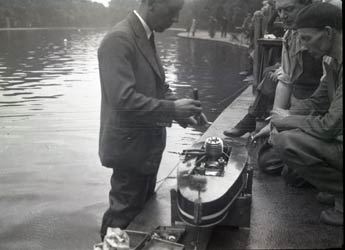 |
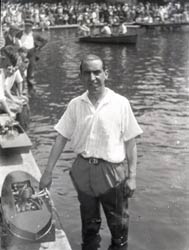 |
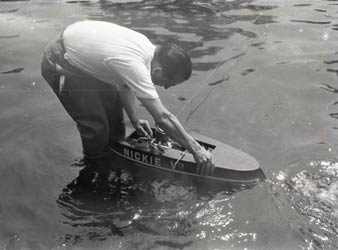 |
| At the International at Victoria Park with 'Nickie V' | ||
|
|
As well as his hydroplane racing, Suzor ran a very successful model shop on the Boulevard Montmorency in Paris and was also highly involved with model railways, model boats and flying model aeroplanes, setting several records with these. Gems Suzor was a prolific designer of engines, large and small, for which he supplied castings and drawings. His first diesel, the Etheromane, has been reproduced many times over the years. To accompany his design Suzor wrote a book entitled ‘Petits Moteurs Pour Modeles reduits’, roughly translated as small motors for small, scale models, which he published in 1938. Time spent on these other ventures had Suzor visiting Victoria for the International for the first time as a guest and presenting the prizes. By 1938 Suzor had also been elected as Vice President of the Model Air-Club of France. In July 1939 at the Tuileries, 'Nickie V' came to grief, diving in at around 44mph and destroying the engine completely. In a letter he sent to ME he lamented that "for 'Nickie V' is no more. She will never appear again". Photos show the crankcase split in half completely. |
|
Although there was no official hydroplane racing during WW2, many clubs and enthusiasts continued to run, including Suzor. How he managed this during the German occupation can only be imagined, but during 1942 he published ‘Mechanique et Modeles’, which covered all aspects of modelling, including ‘moteurs a explosion and a vapeur, (IC and steam engines). This was later published again, but in instalments after the war. |
|
|
|
|
In 1943 he also introduced a D class for 10cc boats weighing no more than 2.5kg, still the weight we run to today for 10cc A3 hydros. With a Brown Junior for power, he set a French record in October of 23mph over 500m with a boat called ‘Tiny Box’. In July 1944 with ‘Nickie VI’ he set another French record, this time for B Class boats. Running 10cc, 15cc and 30cc boats showed a prolific output and a gathering interest in other aspects of the sport, culminating in a flash steam boat called ‘Quacky Ducky’ that appeared in 1945. The name is reputed to be in honour of the first duck meal for many years. As well as the steamer that set a French record at 38mph Suzor was working on a 10cc engine of his own and also in 1945 set a free flight model aircraft record of 45km. In his book he does make reference to the difficulties of working and running boats during the occupation of ‘le Boche’.
 |
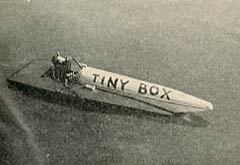 |
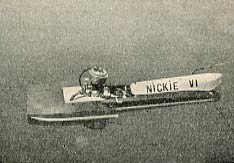 |
Remarkably, Suzor was back in Britain in September 1946 for the Grand Regatta at Victoria Park with the new 10cc motor and a new boat. The boat was called ‘Mlle Sylla’ after his younger daughter and featured a surface prop, but unfortunately capsized on both runs and then again in the afternoon after being repaired. ‘Mlle Sylla II’ soon followed, which, as ‘Zepher’, was a design he published. On its first appearance at the 1947 International Suzor had introduced another development that would become universal to the present day, a second bridle from the transom. Its effectiveness can be judged by the fact that ‘Sylla’ was faster than either the 15cc or 30cc boats, winning the Victory Cup in the process. The twin bridles and articulated drive shaft changed tethered hydroplane running completely, not necessarily the original thoughts of Suzor, but certainly introduced into Europe by him.
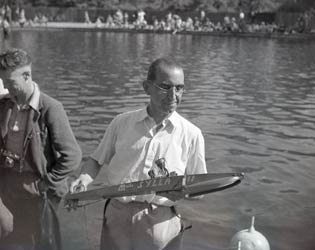 |
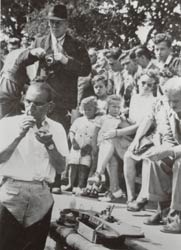 |
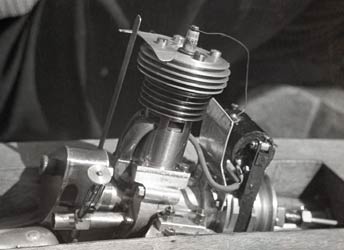 |
| Suzor at Victoria for the 1947 'Grand Regatta' with 'Sylla' and its unique motor. | ||
|
|
Suzor came to Victoria in 1948 with two boats, the 10cc ‘Sylla’ and a new 30cc ‘Nickie’, now number 8, using the four stroke motor from 'Nickie 7', which finished 4th in the A class. ‘Sylla’ won the Victory cup again but tethered hydroplane racing in general and the 10cc class in particular was experiencing an upheaval that would change the future of the sport. This was down to George Stone and his Dooling engined ‘Lady Babs’ that was nearly 30mph faster than any other boat. During 1949 Suzor appears to have concentrated on the 30cc class with ‘Nickie 8’ finishing second in both the French and Swiss International regattas. The Hispano-Suiza International meeting used to be held each year in the country of the previous winner so coming to Allstree Park in Derby in 1950. Suzor appeared with a new 10cc boat, ‘Sylla V’, a radical hull design with an even more radical engine that had no conventional transfer passages as such, ‘squirting’ the new charge from the crankcase into the cylinder through fresh air. This was only possible through the relaxation of the silencer rule for this one meeting. At just over 40mph the boat was again 30mph slower than ‘Lady Babs’. |
|
At the Paris International in 1951 Suzor had ‘Nickie 8’ back in action but finished third behind Ernie Clark and Ken Williams and 14mph off the pace. For the following year he had also gone the two-stroke route for his 30 with ‘Nickie 9’ that he brought to St Albans for the two-day meeting without any great success. There was little racing for Suzor for the next two years through pressure of his business but he did return to St Albans in 1955 having gone the route being favoured by most 10cc competitors of the period in using an American, commercial motor. The superiority of these motors is illustrated by his run in Paris at 78mph, his fastest ever, by a huge margin.
|
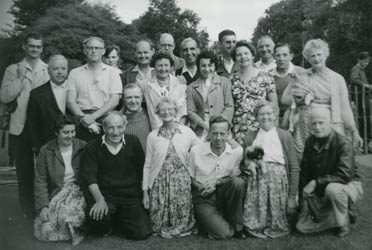 |
 |
Suzor travelled to America in 1956 where both his daughters lived so did not race in Britain but came back in 1957, along with several other French competitors and his 10cc boat, now renamed ‘Nickie X’. This boat did not last long as it disintegrated in Paris after the bridle snapped at around 70mph. The boat was rebuilt again for the 1958 season but fitted with a home built engine to run in Class C where it won at both St Albans and Paris. Suzor’s fifth decade of racing started at St Albans in 1960 where ‘Nickie X’ finished second to the then world record holder, Jean Menant in the Speed trophy. In 1961 he won the C Class yet again before changing his own engine for a French Micron that increased the speed of the now aged boat somewhat. He was reducing his racing commitment considerably by this time but still found time to design a 5cc boat that he sold plans for from his shop. |
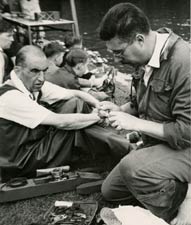 |
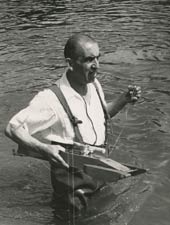 |
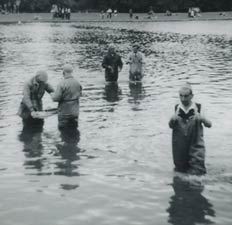 |
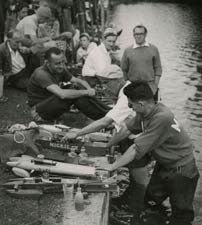 |
| Suzor with Menant | Suzor Nickie X | Suzor at St Alban's | With Grenier and Menant |
|
The last appearance of Gems Suzor in Britain was at the 1964 International meeting at St Albans with another new boat, ‘Nickie XI’ that was fitted with an obscure American motor, which could not compete with the McCoys and newly arrived Italian Rossi motors. This may have contributed to his retirement from tethered hydroplane racing as we can find no evidence of any involvement beyond then? |
|
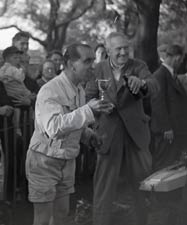 |
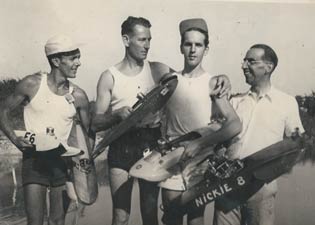 |
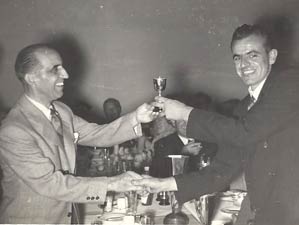 |
| A winner | With George Stone and Chevrot brothers, Geneva | Presenting cup to Stan Poyser |
|
|
His interest in boats and hydros continued though as he was known to be working on a new flash steam hydro in 1964, possibly called 'Sylvia', which had a Stuart Turner Sun engine. A more modern poppet valve motor was also under development. Radio Control was another boating diversion with a cruiser called 'Cecilia' that he demonstrated to Charles Ritz and Joseph Martin when they visited Suzor and Edith in 1964. They were also able to view Suzor's huge collection of models dating back to early tinplate steam locos, one of which he was inordinately proud. In 1966, Suzor, along with R.O. Porter, another hydro man and engine builder presented a trophy, not for hydros, but for functioning ship models. This was re-named the 'Suzor Friendship Trophy' in 1967 and intended for presentation at the St Alban's International. After 1977 there is no further mention of it, so Peter Hill enquired if anyone had any information about it. Is it still in existence? |
|
So ended a long and illustrious racing career and lifetime of designing boats and engines, as well as running his model shop in Paris. Shortly after retiring from running his shop, Gems Suzor died on the 21st of May 1969, but as far as is known, no obituary was ever published in the model press. This was not entirely the end of the Suzor connection with tethered hydroplanes though as the International meeting at Payre in 2000 was dedicated to Gems Suzor and through a superb piece of detective work, Pierre Barbotin discovered that Suzor's youngest Sylla had moved back to France and was living near Poitiers. She, along with her husband and nephew were invited along to officially open the new lake, an event attended by Arthur Wall, John DeMott, Dave Whelan, Mike and Jonathan Drinkwater from Britain. The Suzor trophy was awarded for the 30cc Class, which was won by John DeMott. |
|
Apart from plans for his boats and engines along with copies of his books and magazines, little that can be directly connected with Gems Suzor seems to have survived. Two engines that bear his name are still in existence, one of them seen and photographed back in 1964 reappeared in Britain some forty years later. The remains of another have only recently been discovered.
|
|
|
|
Thanks to Peter Hill for the bulk of the text which has been edited down from a much larger series of articles that he had published in 1995/96. Photos by courtesy of the Westbury family archive, Eric Offen, Ken Lawton, James Stone and Jim Free.
©copyrightOTW2020